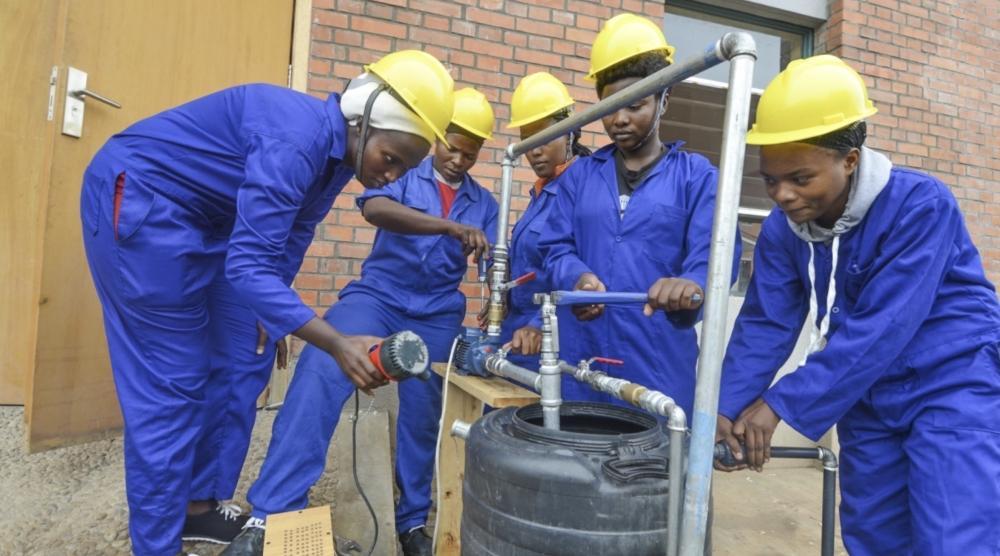Roman Troxler
Africa-Press – Rwanda. For too long, technical and vocational education has been treated as a fallback- for those who didn’t make the cut, or for sectors seen as low prestige. But in today’s Rwanda, that logic no longer holds. If we’re serious about transforming our economy, closing the skills gap, and creating dignified jobs for hundreds of thousands of youth, then TVET isn’t Plan B. It’s Plan A. And we must start treating it that way.
There’s a quiet revolution underway in Rwanda – one that doesn’t announce itself with fanfare or towering infrastructure, but with the tap of a hammer in a carpentry workshop, the hum of welding tools in a vocational school, and the quiet resolve in the eyes of a young woman mastering coding skills in Nyabihu.
At stake is nothing less than the future of work in Rwanda. By 2050, Africa’s working-age population is expected to double to over 1 billion people (World Bank, 2022). In Rwanda, approximately 65% of the population is under the age of 30, with an estimated 300,000 to 400,000 youth entering the job market each year – a sharp rise from previous years. This demographic momentum presents both a pressing challenge and a powerful opportunity for inclusive growth (National Strategy for Transformation, 2025–2029). Yet formal employment opportunities remain limited, and many graduates are finding that a diploma alone is not a ticket to economic mobility.
That’s why Rwanda’s drive to build a dynamic, demand-responsive Technical and Vocational Education and Training (TVET) system matters. But as the recent Rwanda Future Skills Forum reminded us, this is about more than filling labour market gaps. It’s about ensuring that skills development becomes the foundation for inclusive, dignified, and forward-looking livelihoods.
Across the continent – from Ghana’s artisan cooperatives to Kenya’s dual apprenticeship networks-there’s a growing consensus: technical excellence and equity are not mutually exclusive. They are mutually reinforcing. Ghana’s “MyTVET” campaign, for instance, elevated the visibility and quality of vocational education while prioritising access for women, rural youth, and persons with disabilities. The result? A broader base of learners entering stronger, market-aligned programs.
Rwanda is making similar strides. The rollout of competency-based curricula and the growing involvement of private sector actors are already yielding results. But we must continue to challenge a stubborn misconception: that excellence belongs to the few, and inclusion comes at its expense. True transformation means ensuring that the daughter of a farmer in Nyagatare and the son of a mechanic in Huye both see TVET not as a second-tier option – but as a launchpad opening up a wide range of opportunities.
The how matters. No single actor can do it alone. In Senegal, the Fonds de Financement de la Formation Professionnelle et Technique (3FPT) has demonstrated how a tripartite model – where employers, training providers, and government share responsibility for financing and quality – can contribute to more responsive systems. In Kenya, the PropelA Dual Apprenticeship Programme is showing what collaboration can look like in practice. The programme brings together vocational training centres, sector associations, and leading businesses to jointly design and deliver training. Apprentices spend nearly 70% of their time in real work environments, and the early results are telling: graduates are not only more employable – they are more confident, adaptable, and industry-ready.
In Rwanda, our dual apprenticeship pilots have drawn on these lessons. But to scale them sustainably, we must strengthen trust among partners, let the private sector do-design and co-steer the system, embed real-time feedback loops, and provide training institutions the autonomy to innovate. After all, the future of work is fluid. Our systems must be too.
Flexibility isn’t a buzzword – it’s a lifeline. As AI, climate adaptation, and digital platforms reshape entire industries, our curricula, standards, and assessment models must evolve. Nigeria’s challenge with fragmented certification systems shows how costly inflexibility can be. In contrast, Kenya’s decade-long journey to strengthen its TVET Authority offers a model of steady, adaptive reform.
Still, even the best policy designs can falter if rushed. Building robust skills systems requires a long view. Trainers in TVET schools as well as instructors in companies need time to be onboarded and upskilled. Institutions need time to mature. Employers need time to see the value of investing in apprenticeships. Change moves at the speed of relationships – and relationships are built on trust.
Most importantly, we must embrace iteration. Rwanda’s dual apprenticeship model is not a final product – it’s a learning process. One that will be refined, challenged, and improved by the very learners, trainers, and employers who breathe life into it. That’s not a sign of failure. It’s a marker of relevance.
Ultimately, the task ahead is not just to design better training programs, but to strengthen the national and local systems that sustain them – systems that are inclusive, adaptive, and anchored in real economic opportunity. The Rwanda Future Skills Forum was a timely reminder that meaningful transformation does not happen in isolation. It requires sustained collaboration, long-term investment, and a shared belief in the potential of every learner. We are not merely preparing young people for the jobs of today – we are equipping them to shape the future itself. And that is work worth doing well. TVET is not a fallback plan. It is Rwanda’s best bet.
Source: The New Times
For More News And Analysis About Rwanda Follow Africa-Press






